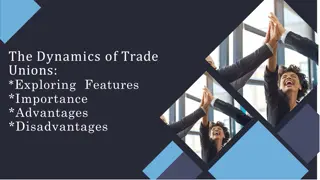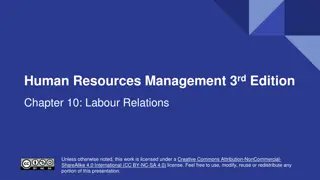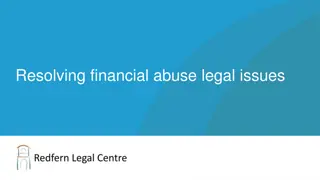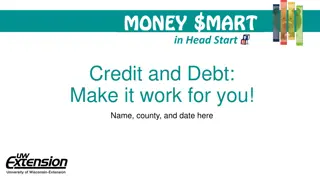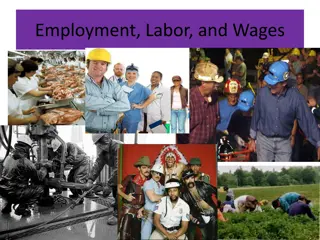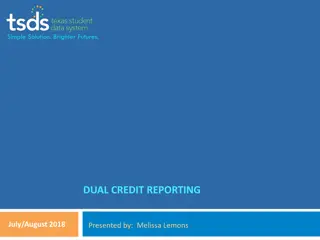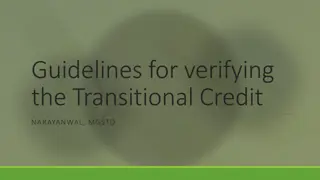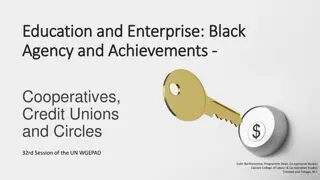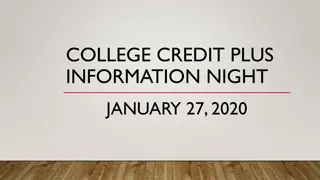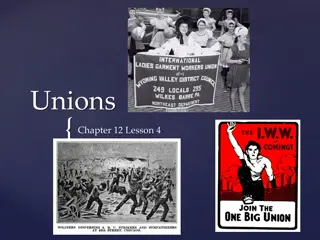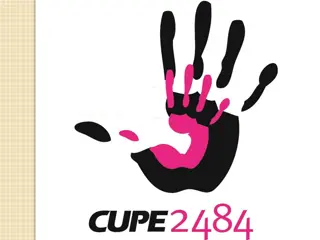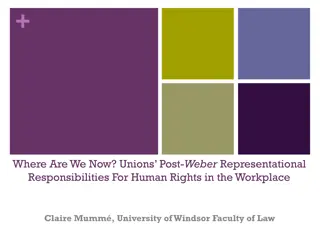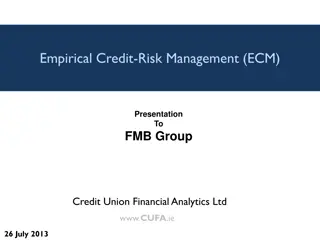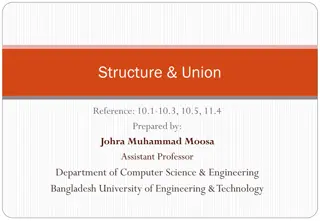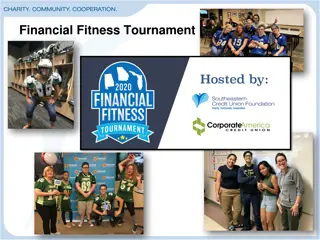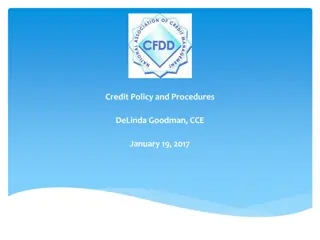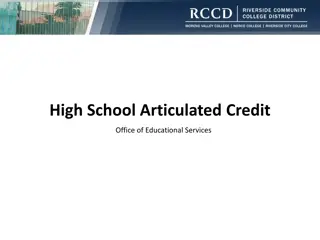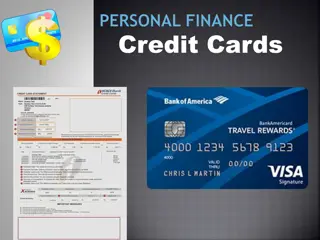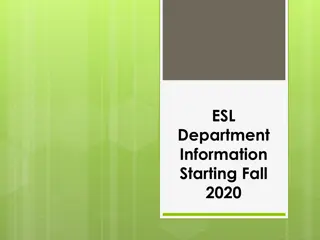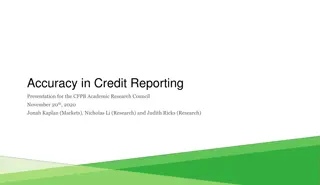The Dynamics of Trade Unions: Features, Importance, Advantages, Disadvantages
Trade unions are organizations formed by workers to protect their rights and negotiate with employers for better working conditions, wages, and job security. They play a crucial role in advocating for fair treatment, job security, and improved workplace conditions. While trade unions offer advantage
2 views • 10 slides
Labour Relations: History, Unionization, and Objectives
Explore the historical development of labour unions, reasons for changes in union membership, the process of unionization, collective bargaining, grievance management, and the role of HR in working with unions. Uncover the impact of unions on wages, benefits, job security, and working conditions, as
2 views • 16 slides
Dual Credit Options at Champion High School
Champion High School offers Advanced Placement (AP) and Dual Credit programs in partnership with various institutions like Northwest Vista College, Angelo State University, UT On-Ramps, and Tarleton Today. Students can earn college credit by meeting testing requirements, with some classes being free
1 views • 14 slides
Resolving Financial Abuse: Legal Issues and Consumer Credit Law
Learn about resolving legal issues related to financial abuse, consumer credit law, crafting financial hardship requests, negotiating with creditors, getting specialist legal advice, and testing your knowledge on financial matters. Gain insights into consumer credit law, the National Consumer Credit
0 views • 67 slides
Certified Credit Union Financial Counselors 2020 Graduates Presentation
A presentation highlighting the 2020 graduates of Certified Credit Union Financial Counselors from Alabama and Florida. The presentation showcases the names of the graduates from various credit unions, recognizing their accomplishment and dedication in the field. The graduates represent a diverse gr
0 views • 6 slides
Credit Reports and Scores: A Comprehensive Overview
Explore the importance of credit reports and scores in financial empowerment through modules on reviewing credit reports, understanding credit scores, and mastering credit basics. Learn how good credit can impact your ability to obtain loans, credit cards, secure rentals, insurance coverage, and emp
3 views • 35 slides
Mastering Credit and Debt in Head Start Program
Understand the complexities of credit and debt to make informed financial decisions. Learn about different types of credit, pros and cons of credit cards, debit cards, prepaid cards, and secured credit cards. Gain insights on how to manage your finances effectively and build a strong credit history
0 views • 29 slides
Qualitative Credit Control Methods Explained
Selective/Qualitative credit control methods involve regulating the quality and direction of credit flows by implementing controls such as ceilings on credit, margin requirements, discriminatory interest rates, directives, direct action, and moral suasion. These methods are used by central banks lik
0 views • 7 slides
Middle Income Housing Solutions for Credit Unions and Members
Providing practical approaches for middle income housing solutions beneficial to Credit Unions and members. Addressing the lack of assistance for middle income housing and the needs of Credit Unions, developers, and members for quality housing solutions, loans, and affordable payments.
0 views • 14 slides
Credit Reporting and Credit Scores in CARE Presentation
Explore the essential concepts of credit reporting and credit scores in the context of Credit Abuse Resistance Education (CARE). Learn about credit history, its impact on financial decisions, ways to establish credit, the significance of credit reports, and how credit behaviors affect one's financia
0 views • 21 slides
Evolution of Labor Movement in America: From Printers to Industrial Workers
Labor movement in America started in 1778 when printers in New York City demanded higher pay, leading to the formation of labor unions. Over the years, the workforce shifted from farmers to factory workers due to immigration and industrialization. The Civil War and westward expansion further fueled
2 views • 34 slides
Importance of Strategic Planning for Unions in Today's World
Strategic planning is crucial for unions in navigating the complexities of today's environment. Without a clear strategy, a union may struggle to achieve its goals and respond effectively to external influences. Strategic planning goes beyond reactive approaches, providing a roadmap for success by e
1 views • 33 slides
Credit Cards: A Beginner's Guide
Explore the basics of credit cards, including how they work, differences from debit and prepaid cards, obtaining one, and building credit. Learn about credit character, revolving credit, and tips for getting approved for a credit card. Discover the importance of good credit and income when applying
0 views • 20 slides
Understanding Credit Reports and Building Credit in 2017
Understanding credit reports is essential for financial well-being. A credit report is a record of your payment history on loans and credit cards. This report is used to calculate your credit score, which determines your creditworthiness. Building and maintaining credit involves making payments on t
5 views • 22 slides
Dual Credit Reporting Guidelines for College Courses
Dual Credit Reporting provides definitions, guidelines, and validation rules for reporting college courses that allow students to earn both high school and college credit. Key elements covered include credit indicators, college credit hours, course sequencing, and validation rules to avoid overrepor
0 views • 6 slides
Guidelines for Verifying Transitional Credit and Important Authorities' Orders
The guidelines for verifying transitional credit include directives from the Hon'ble Supreme Court, the opening of a common portal for filing forms, the verification process timeline, and the reflection of approved transitional credit in the Electronic Credit Ledger. Relevant orders and circulars fr
4 views • 19 slides
Child and Dependent Care Expenses Credit
The Child and Dependent Care Expenses Credit allows taxpayers to reduce their tax liability by a portion of expenses incurred for caring for qualifying persons. Qualifying persons include children under 13, incapacitated spouses or dependents, and certain criteria must be met to claim the credit. Th
8 views • 10 slides
Empowering Black Communities Through Cooperative Enterprises
Explore the significance of cooperatives, credit unions, and circles in empowering Black communities, highlighting their role in economic, social, and cultural development. With over 760 million individuals benefiting from the Cooperative Advantage, these community-centered models prioritize people
1 views • 11 slides
The Case for Private Credit Investments in the Global Market
Private credit investments are gaining significance in the global market, offering innovative financing solutions outside traditional avenues like public markets. With a focus on innovation, independence, and integrity, private credit investments cater to diverse sectors such as real estate, natural
1 views • 9 slides
Take Control of Your Credit Report: A Comprehensive Guide
Learn how to take control of your credit report, understand why it matters, spot credit repair scams, and fix mistakes. Discover why your credit history is important and how to get your free credit reports. Explore the significance of your credit score, review your credit reports, and know how to ha
0 views • 16 slides
Enhancing Credit Unions' Potential with CredUView Consulting
CredUView Limited offers consultancy services tailored for credit unions and cooperatives, focusing on educational development, millennial engagement, and performance enhancement. Founded on principles of empowerment and community integration, led by seasoned professionals, CredUView drives credit u
0 views • 34 slides
College Credit Plus Information Night - Benefits, Challenges, and Considerations
College Credit Plus (CCP) offers students in grades 7-12 the opportunity to earn high school and college credit simultaneously. This program has advantages such as cost-free college credit, textbooks paid for by Padua, and the ability to graduate early. However, potential challenges include impacts
0 views • 16 slides
Variants and Unions in C++
Variants and unions are essential concepts in C++ programming for managing heterogenous data and optimizing memory usage. Variants allow storing objects of multiple types in a single container, while unions provide a way to efficiently utilize memory by sharing the same storage space for different t
0 views • 26 slides
The Rise of Unions and Labor Conditions in the Late 19th Century
Labor conditions in the late 1800s were harsh, with long work weeks, low wages, and no benefits for workers. Deflation caused a rise in the value of money, leading to resentment among workers who organized into unions to demand better wages and working conditions. Craft workers and common laborers f
0 views • 17 slides
Labor Unions and Collective Agreements in the Workplace
A labor union, also known as a trade union in British English or a labor union in Canadian English, is formed by workers to achieve common goals such as better pay, improved working conditions, and job security. Through collective bargaining, unions negotiate with employers to improve wages, benefit
1 views • 29 slides
Unions Post-Weber: Representational Responsibilities For Human Rights
This presentation by Claire Mumm from the University of Windsor Faculty of Law discusses the impact of expanded jurisdiction over human rights issues post-Weber on unions' representational responsibilities for their members. It delves into the changes in DFR case law, claims against unions at Human
0 views • 37 slides
Empirical Credit Risk Management at FMB Group Credit Union
Empirical Credit-Risk Management (ECM) presentation to FMB Group Credit Union by Financial Analytics Ltd discusses the background, traditional forecasting methods, income and risk recognition, provisioning approaches, and benefits for credit unions. ECM offers expert retail credit risk management th
0 views • 25 slides
Promoting Solidarity and Rights of Workers Globally through International Trade Unions
Joining trade unions and engaging in international work is crucial for promoting solidarity, protecting workers' rights globally, and challenging exploitation by multinational companies. UNISON's National LGBT+ Committee is actively involved in international work, aiming to advocate for LGBT+ worker
0 views • 16 slides
Industrial Relations and Trade Unions
Industrial relations refer to the management-employee relationships within a firm, and trade unions represent employees' interests in negotiations with employers. This article discusses the roles of trade unions, causes of industrial disputes, actions in industrial conflicts, types of disputes, deci
0 views • 20 slides
Credit Derivatives and Managing Credit Risk
This chapter delves into credit derivatives, exploring their purpose, types such as credit default swaps and total return swaps, and the development of the market over the years. It discusses credit risk, problems associated with it, methods for estimating credit risk, and the role of credit derivat
0 views • 35 slides
Principles of Credit in Agricultural Financing
Explore the key principles guiding credit in agricultural financing as outlined by Dr. J.P. Singh, including the Five Cs of Credit and the Seven Ps of Credit. Learn about the importance of factors such as productive purpose, productivity, and proper utilization in ensuring successful lending practic
0 views • 7 slides
Structures and Unions in C Programming
Exploring the concept of structures and unions in the C programming language, this reference material covers their definition, initialization, assignment, members, arrays, and nested structures. Learn how structures aggregate data types and how unions can share memory locations. Gain insights into s
0 views • 20 slides
Financial Institutions and Concepts
Explore important topics in finance such as the Federal Deposit Insurance Corporation (FDIC), credit unions, stockholders, savings and loans, cyber banks, credit cards, due dates, creditors, credit limits, grace periods, and insurance agents to enhance your financial literacy journey.
0 views • 29 slides
Financial Fitness Tournament 2020 Overview
Explore the Financial Fitness Tournament 2020, where participating credit unions aim to address financial challenges faced by Americans, such as inadequate savings and rising debts. The event encourages financial education and offers valuable prizes for students. Discover alarming statistics and the
0 views • 10 slides
Empowering Women and Youth in African Trade Unions
Trade unions play a vital role in addressing labor challenges and promoting decent employment. Gender equality is key, with Africa having examples of female-led unions. Empowering women and youth in union leadership structures is essential for real benefits. Diversifying leadership positions can enh
0 views • 33 slides
The Importance of Credit Policies in Business Operations
A credit policy/manual serves as a comprehensive guide detailing rules, regulations, and procedures within a company. It helps new employees understand the company's credit processes and establishes clear guidelines for decision-making. Without a credit policy, conflicts may arise in approving credi
0 views • 9 slides
High School Articulated Credit: Benefits, Transferability & Responsibilities
High school articulated credit allows students to earn college credit by aligning high school CTE classes with college-level courses. This collaboration between high school teachers and college professors can save students time and money by reducing the need to repeat coursework in college. Students
0 views • 8 slides
All About Credit Cards: A Comprehensive Guide
Explore the world of credit cards, from understanding the basics to managing credit wisely. Delve into the advantages and disadvantages, learn about different types of credit cards, and discover how to use credit cards responsibly. Discuss whether high school students, college students, and adults s
0 views • 36 slides
Comprehensive Information on ESL Department's Fall 2020 Offerings
Explore ESL class options starting Fall 2020, including credit vs. non-credit courses, new course offerings, course numbering system, differences between credit and non-credit classes, and more. Discover details on certificates, financial aid, graduation, and transfer information, with insights on c
0 views • 12 slides
Evolution of Credit Reporting and Consumer Awareness
Credit access is crucial for consumers, yet inaccurate credit reporting can have significant impacts on credit scores. Studies show that errors in credit reports are common, with many consumers disputing inaccurate information. The regulatory landscape has evolved since the 2012 FTC study, with incr
1 views • 10 slides
